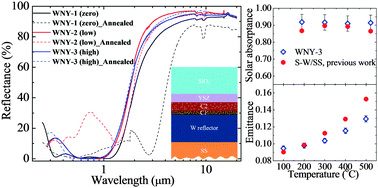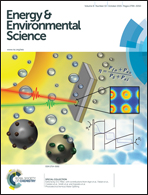A high-performance spectrally-selective solar absorber based on a yttria-stabilized zirconia cermet with high-temperature stability†
Abstract
Spectrally-selective solar absorbers are widely used in solar hot water and concentrating solar power (CSP) systems. However, their performance at high temperatures (>450 °C) is still not satisfactory due to high infrared (IR) emittance and lack of long-term thermal stability. Here, we explore yttria-stabilized zirconia (YSZ) cermet-based spectrally-selective surfaces for high-temperature solar absorber applications. The developed multilayer selective surface comprises two sunlight-absorbing W–Ni–YSZ cermet layers with different W–Ni volume fractions inside the YSZ matrix, two anti-reflection coatings (ARCs), and one tungsten IR reflection layer for reduced IR emittance and improved thermal stability, deposited on a polished stainless steel (SS) substrate. The fabricated solar absorbers are tested for their long-term thermal stability at 600 °C. We find a distinct change in the surface morphology of the solar absorbers when oxygen is highly deficient in the YSZ-ARC layers. The oxygen deficiency can be effectively overcome through increasing the oxygen partial pressure during sputtering, which leads to a stable solar absorber with a solar absorptance of ∼0.91 and a total hemispherical emittance of ∼0.13 at 500 °C. Those values are obtained at the actual operating temperature using an absolute and direct method that measures the total hemispherical emittance with high accuracy. In contrast, most reports on solar absorber development in the literature to date use only near room-temperature spectroscopy techniques that have been shown to significantly underestimate the total hemispherical emittance. This makes our experimentally demonstrated total hemispherical emittance value the lowest ever reported for a high-temperature stable solar absorber with solar absorptance above 0.9.


 Please wait while we load your content...
Please wait while we load your content...